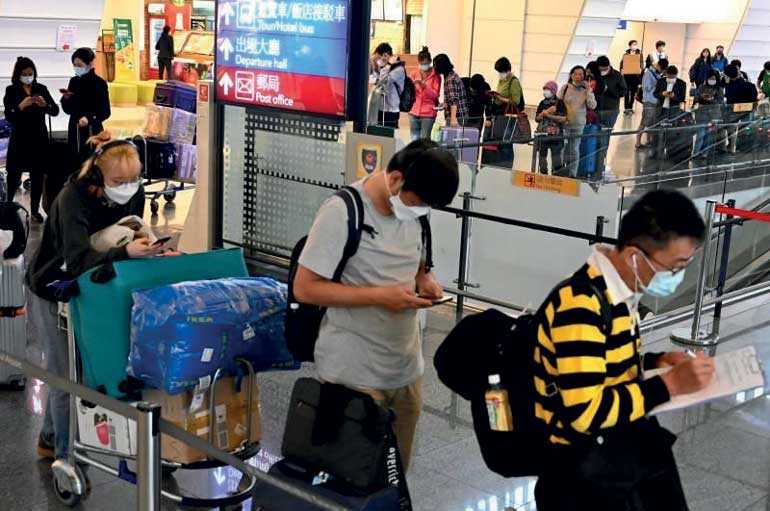Monday Dec 29, 2025
Monday Dec 29, 2025
Tuesday, 31 March 2020 00:00 - - {{hitsCtrl.values.hits}}

As of 30 March, Taiwan, originally expected to have one of the worst outbreaks due to proximity with the Mainland, and the flow of migrant workers, still stands at 298 total cases and three deaths. While studying South Korea and Singapore is fully warranted, Taiwan deserves scrupulous attention as a positive outlier
A disease-modelling study recently released from the University of Oxford makes the claim that the majority of coronavirus infections are so mild as to have already passed unrecorded by the authorities and potentially also by the people infected.
This is a serious university study, much hated by the “hysteria industry” for whom the pandemic is a true gold-mine. The rest of us have to intelligently play “agnostic” and “sceptic” with these claims and continue to err on the side of humanity (both medically and economically I should add).
But if this is the case, a large percentage of those in Asia and Europe may have already had the virus and developed a degree of immunity. Therefore, what that would entail would be to allow the lockdowns in the US (which while they are regulating flow of people are not curfews, hence Government can stay focused on medical and economic response) to have their necessary four to six weeks, hopefully let the pressure diminish on intensive care units, and we may turn a decisive corner.
Part of what set off the media conflagration was a far grimmer study emerging earlier from Imperial College, London. Again, our current data is so incomplete, it could underwrite either hypothesis… almost.
The Imperial College study was based on literally nothing being done to contain the virus. Neil Ferguson who was the primary architect of the study has now radically scaled the projection of deaths back drastically in the UK from 500,000 to fewer than 20,000 in just a few weeks. And this may get scaled back further as more responses are undertaken. Hence, I believe we owe it to our rational faculties, and wanting to preserve a working world, to investigate the Oxford claims.
There is a scramble to get data on representative sampling of populations (Iceland, given limited population, has done one, as has the Italian town of Vo, resulting in a finding of a lower than 1% infection rate in the latter, even less in the former).
Iceland, with a private biopharmaceutical company, deCode Genetics, administered more than 12,615 tests across the country, about 3.5% of the population, irrespective of whether the people had symptoms or not. About 1,020 infections (.28%) as of 29 March were identified. About half the people tested positive, showed no symptoms. Free testing is being offered far and wide. No lockdown yet, certainly no curfew, but banned gatherings above 20 people, quarantine measures, testing and retesting. Other Iceland stats as of the same date: Two deaths.
The town of VO near Venice, tested and retested 3,300 inhabitants regardless of whether they were showing symptoms, rigorously quarantining their contacts (South Korean model essentially), and they have effectively stopped the spread of the illness there as of last reporting, a major breakthrough and heartening to all.
Avoiding mass events
On the other side of the ledger, it is likely Mardi Gras, with its mass pooling of population in late February in New Orleans is one of the culprits behind the huge spike of cases in Louisiana. New York’s population density and the number of global travellers flowing through before border controls are likely catalysts there.
Bergamo in Lombardy, one of the Italian epicentres in Lombardy was likely triggered in part by mass attendees returning from a Champion’s League Match in Milan while the virus was being scoffed at. Those attendees accounted for almost one-third of the entire town. The match, which has been termed “Game Zero” occurred roughly two days before the first case of locally transmitted COVID-19 was confirmed in Italy.
Apparently, 40,000 people were hugging and kissing, standing a centimetre apart at the match; and pictures of Mardi Gras in New Orleans make a similar case in and of themselves!
Back to the Oxford study and beyond
To gather the necessary evidence, the Oxford group is working with colleagues in the Universities of Cambridge and Kent to start antibody testing on the general public as soon as possible to get a reliable readout of protective immunity.
Professor Ionnidis, who I referenced in an earlier article, from Stanford, and other experts in the field, are avidly seeking to get representative sampling data both in the US and globally. This will likely not be forthcoming for weeks, but we can hope for it within April.
Growing consensus though indicates the 3.4% WHO mortality rate projection is seriously flawed, as it was based on those already sick, not those simply infected who may have mild symptoms or may be asymptomatic. If the actual rate is 0.7% to 1.0% as being currently conjectured by medical experts in the field, that is serious, but not apocalyptic. It may also be much lower, it could of course suddenly be much higher (though as of today we have no firm data basis for confirming either speculation).
Sane responses
We are witnessing currently, fairly globally, a “small business apocalypse” and there are sectors being, potentially, irretrievably damaged. The wolf will come calling at the door next of whole business sectors, industries, developing countries.
To refuse to think about that, thinking we can “buy our way out of this” with other people’s money (those same people are feeling their own sharp contraction of demand and liquidity), without seeking to accelerate a return to some step-ladder approach to economic functioning, is myopic or indulging in “magical thinking” like those who deny the impact of climate change.
So we must have different scenarios plotted, different mitigating strategies ready, and be actively enrolling private and public sector to be ready to execute in concert based on milestones and/or gates, decisively and consistently.
That way, if Oxford is right, we’re ready. And if they’re not, and we need to extend our caution, then we can be more targeted, more focused, and still find ways to move forward with acceptable ways to manage risk, without essentially compromising the viability of society or the country going forward.
And so this brings us to the curious anomaly of Taiwan. Long touted as one of the trio of early responders who did not have to bring their economy to a complete standstill (along with Hong Kong and Singapore), WHO was asked about Taiwan recently in a press conference, and with “pandemic” nervousness extolled China’s response as a whole. The Taiwanese leader was mortified that his country’s name couldn’t even be publicly uttered.
Leaving aside such perhaps understandable political sensitivities, as of 30 March, Taiwan, originally expected to have one of the worst outbreaks due to proximity with the Mainland, and the flow of migrant workers, still stands at 298 total cases and three deaths. While studying South Korea and Singapore is fully warranted, Taiwan deserves scrupulous attention as a positive outlier.